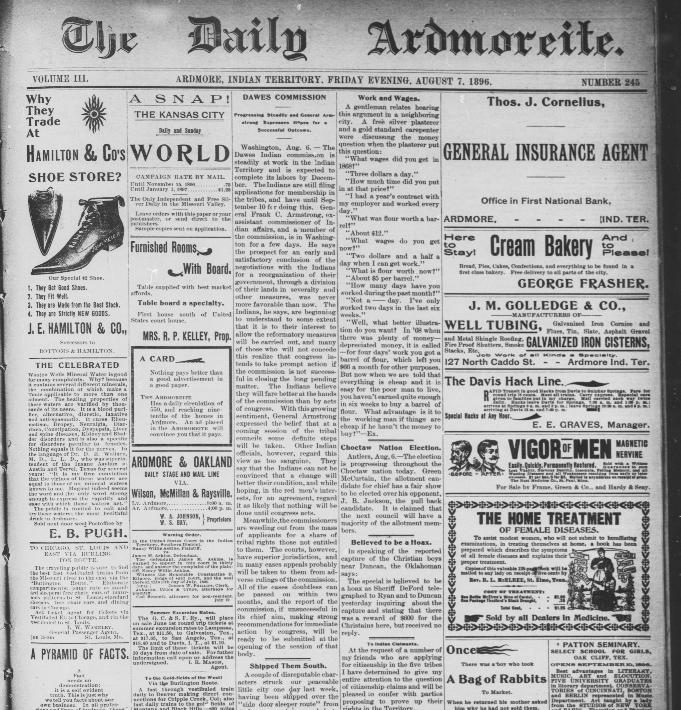|
Moderated by NW Okie! |
Volume 16 , Issue 332014Weekly eZine: (366 subscribers)Subscribe | Unsubscribe Using Desktop... |
August 1896, Dawes Commission

According to The Daily Ardmoreite, out of Ardmore, Indian Territory, dated 7 August 1896, Friday evening, one of the front page headlines read: Dawes Commission. It was reported as progressing steadily and General Armstrong expressed hopes for a successful outcome.
Washington, Aug. 6 (1896) -- The Dawes Indian commission was steadily at work in the Indian Territory and was expected to complete its labors by December. The Indians were still filing applications for membership in the tribes, and had until September 10, 1896 for doing just that. General Frank C. Armstrong, ex-assistant commissioner of Indian affairs, and a member of the commission, was in Washington for a few days. He said the prospect for an early and satisfactory conclusion of the negotiations with the Indians for a reorganization of their government, through a division of their lands in severally and other measures, was never more favorable than back in 1896.
The Indians were beginning to understand to some extent that it was to their interest to allow the reformatory measures would be carried out, and many of those who would not concede this realized that congress intends to take prompt action if the commission was not successful in closing the long pending matter. The Indians believed they would fare better at the hands of the commission than by acts of congress.
With this growing sentiment, General Armstrong expressed the belief that at a coming session of the tribal councils some definite steps would be taken. Other Indian officials, however, regarded this view as too sanguine. They said that the Indians can not be convinced that a change would better their condition, and while hoping, in the red men's interests, for an agreement, regarded it as likely that nothing would be done until congress acts.
The commissioners were weeding out from the mass of applicants for a share of tribal rights those not entitled to them. The courts had superior jurisdiction, and in many cases appeals probably would be taken to them from adverse rulings of the commission. All of the cases doubtless could be passed on within two months, and the report of the commission, if unsuccessful in its chief aim, making strong recommendations for immediate action by congress, would be ready to be submitted at the opening of the session of that body.
| View or Add Comments (0 Comments)
| Receive
updates ( subscribers) |
Unsubscribe
| © . Linda Mcgill Wagner - began © 1999 Contact Me | |
